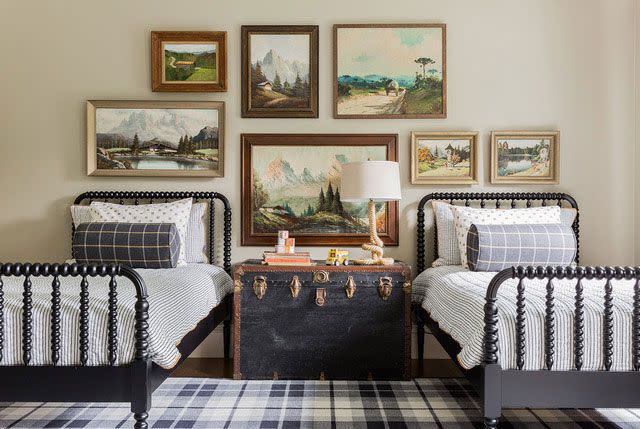Here's How High You Should Hang Pictures, According To Designers
Learn about the 57-inch rule to make your decor look perfectly placed.

Choosing art and decor for your walls is very much a personal matter. But when it comes to showing it off in your space, it’s better to keep an important design principle in mind to avoid haphazardly hammering nails into your walls.
“The general rule of thumb is 57 inches from the bottom of the floor to the center of the piece of artwork,” says Sara McDaniel, Designer of Simply Southern Cottage in Minden, Louisiana. “Typically, that is your eye level.”
It makes sense that you would want wall art at eye level so you don’t have to crane your neck up or down to view it. But it also makes sense that this rule might not always apply—especially if you are vertically challenged/enhanced or if you have some enormous pieces of art waiting to be hung.
Keep reading to find out why the 57-inch rule works—and when you should overturn it for your own design needs.
Meet the Experts
Lucinda Loya is Creative Director at Lucinda Loya Interiors in Houston, Texas.
Sara McDaniel is Designer of Simply Southern Cottage in Minden, Louisiana.
The 57-inch Rule or Eye Level
You may have previously been eyeballing it whenever you hung wall art, but it does help to have a measuring tape handy before you grab the hammer and nails.
“It is very easy to hang art improperly,” says Lucinda Loya, Creative Director at Lucinda Loya Interiors in Houston, Texas. “The biggest mistake I see is art being hung too high.” She says feel free to waver between 55 and 60 inches without setting off any design alarm bells, though she indeed notes the sweet spot usually is 57 inches in a room with a 10-foot ceiling.
“I will hang all others in the home at the same level throughout, regardless of if the ceiling is higher or vaulted,” Loya says. “You want your eye to travel seamlessly around the space.”
Can You Break the 57-Inch Rule?
Of course, you can always plead the “my house, my rules” argument any time you want with home décor. But truly, the interior design police won’t come after you if you hang your wall art outside of the 57-inch rule of thumb.
When she’s working in a space with vaulted or double-height ceilings, Loya says she won’t hesitate to stack pieces to fill the space. “Balance and scale are key to maintaining proper flow,” she explains.
How to Hang Artwork Above Furniture
Loya offers one particular exception to the 57-inch rule: “If the piece hangs over furniture, consider enough air space below for it to float properly above the piece.” The standard range she suggests is six to 12 inches depending on the size of the art, furniture, and space in question; though she finds that eight to 10 inches “works most of the time.”
“This is where your best judgment comes into play,” says Loya. “If there are items or objects atop a console, allow for at least two to three inches above the items.”
McDaniel also says to consider the piece in relation to the furniture itself. If you are hanging wall art (or even a flat-screen TV) over furniture, it should be centered over it regardless of where it is on the wall. “[The piece] could potentially look off-center from the side, but I am looking at it as centered on a piece of furniture,” she says.
Consider the Size of Your Picture
Loya says another design faux pas she also sees is small pieces on huge walls. “Again, scale is critical, and if you find yourself with this obstacle, opt for a salon-style display using multiple pieces to fill the space,” she says. The height rule still applies, but allow for two to three inches between pieces, she adds.
Gallery walls that feature numerous pieces of varying sizes are a good excuse to skirt the 57-inch rule. McDaniel has a couch situated in front of a huge wall and took the opportunity to make a gallery wall with about 10 pieces hung at varying levels.
To really nail your placement (pardon the pun) of your salon-style or gallery wall, both Loya and McDaniel recommend arranging the wall art on the floor first to see if you like the setup.
“Once the composition’s dimension has been determined, divide that number by two using it to find your center point,” Loya says.
And if you’ve got photos of people to hang on a gallery wall, remember that eye level is everything for one particular reason, especially if the photos are of loved ones. “[When] looking at the photo, I'm actually looking into their eyes,” says McDaniel.
For more Southern Living news, make sure to sign up for our newsletter!
Read the original article on Southern Living.

